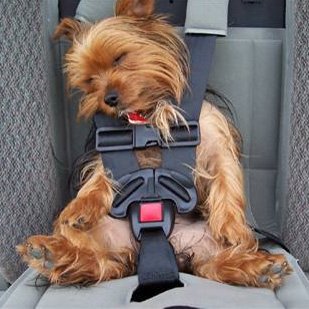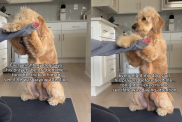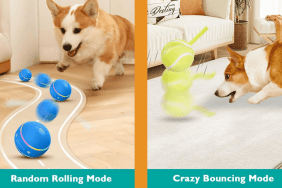Let’s face it, many people have a hard enough time being disciplined about buckling themselves up in the car, much less tending to their dog’s seat belt. And yes, some people laugh at the idea.
But consider this worst-case but all-too-possible scenario: you’re on your way to the dog park or vet when you’re in a car accident, with your dog in the car. The outcome depends on several factors: how bad the accident is, whether or not you are hurt, and whether your pet is restrained–or turned into a projectile who goes through the car window.
In some cases, nothing can prevent a horrible outcome. But you can protect your dog from becoming an unguided missile, or from leaving the scene of an accident in a panic, by restraining her. Another reason to restrain her is if you are unconscious and the dog is hurt; you’ll want animal control to be able to handle her easily enough to get her to a veterinarian.
The best car restraint is one that suits your dog and vehicle
Using any form of car restraint will provide numerous benefits:
- It prevents your dog from going through the window.
- It prevents driver distraction. (Think of Stephen King’s nearly fatal car accident, caused by a driver dealing with an unrestrained dog in his vehicle).
- It allows paramedics to work on you without protective interference from your upset dog.
- It prevents your dog from jumping out a window after squirrels.
- It allows you to leave windows open wider for better ventilation.
As with almost all consumer products, however, you have many choices to consider when choosing the car restraint that will work best for you and your canine pal. They are available in a variety of basic styles:
- A harness holds the dog in via a strap that attaches to the seat belt mechanism. It’s kind of like a leash that attaches to a harness, thus preventing pressure on your dog’s neck if the car is hit.
- Carriers strap right into the seat belt mechanism.
- Other types of carriers, for small dogs, do triple duty as booster seat, carrier, and stroller.
- Booster seats, similar to those for children, are available for small dogs to ride in, lifting them up enough that they can see out the car window while restrained in the booster seat with a belt.
- Barriers, usually made of wire or mesh, block off the backs of SUVs or vans, or they block the middle space between two front seats. These prevent dogs from jumping back and forth over the seats. Barriers do not attach the dog to the car, though, so your pup can still get sent flying through the window if there’s a crash. However, barriers work wonderfully to keep dogs out of the driver’s way.
- Truck restraints are usually a type of harness that attach a dog to the truck’s bed, since riding loose in the back of a pickup truck is dangerous (and illegal in some states).
- Wire crates are effective at keeping your dog in one small space within the vehicle, but they usually don’t fit well in cars and are better suited to SUVs, vans, and trucks.
Of course, the more uses one product offers, the more it’s likely to cost. A harness that attaches to the seat belt system is typically the least expensive option for restraining one dog.
Needless to say, some dogs won’t mind the restraint and others will find it pretty annoying. If your dog has previously had freedom in the car, and she likes to hang her head out the window or tell the drive-through bank teller she’d like a biscuit, she’s probably not going to be a happy camper while first being restrained.
Take heart in knowing that she’ll adapt, and remind yourself that you really don’t want to see her flying out of the car. Naturally, it’s easiest on both of you if you start using a car restraint from the time your dog or puppy joins your household.
What to look for in a car restraint or seat belt
Safety, safety, safety. Before you buy, think about which product will best keep your dog in one place, where she’s out of your way and can’t shoot out of the vehicle if there’s a crash.
If you have more than one dog, you may have to make a compromise. A barrier will keep three dogs in the back of an SUV while all is going well–but it won’t protect them from becoming being tossed around in the event of an accident. A barrier will, however, keep them out of the driver’s way, and probably out of the way of any paramedics who might be needed.
Products that complement a car restraint
A car seat cover, available through most pet supply stores, protects your car seat from getting dirty or muddy and helps maintain the value of your car (it’s harder to sell a car that has tons of dog hair ingrained into crevices and fabric). You can take the cover out and wash it, which is a lot easier than trying to shampoo and dry the car seat itself. Make sure the cover has slits for seat belts.









